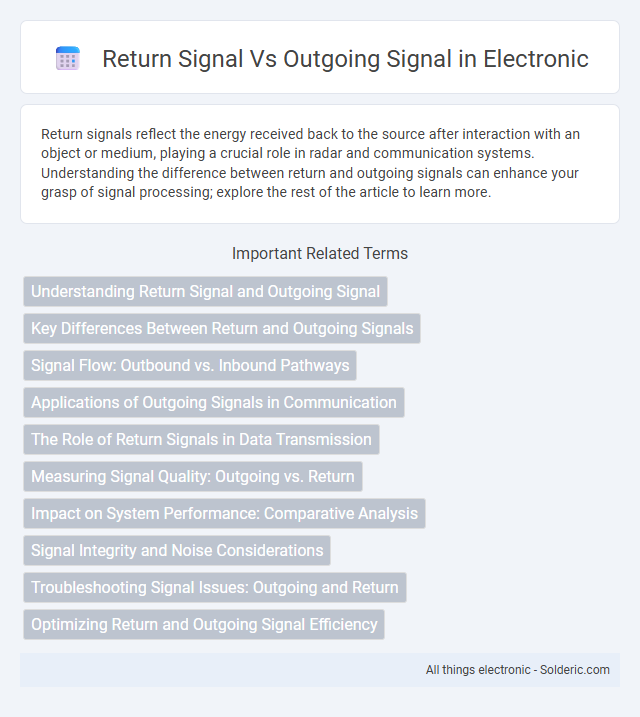Return signals reflect the energy received back to the source after interaction with an object or medium, playing a crucial role in radar and communication systems. Understanding the difference between return and outgoing signals can enhance your grasp of signal processing; explore the rest of the article to learn more.
Comparison Table
| Aspect | Return Signal | Outgoing Signal |
|---|---|---|
| Definition | Signal reflected back to the source after hitting a target | Signal transmitted from the source to the target |
| Purpose | Used for analysis, measurement, or detection of objects | Initiates communication or sensing process |
| Direction | Towards the origin or emitter | Away from the origin or emitter |
| Examples | Radar echo, sonar reflection, wireless feedback | Radar pulse, sonar ping, wireless transmission |
| Signal Quality | Often weaker due to attenuation and scattering | Typically stronger at emission point |
| Information Content | Contains data about target characteristics or environment | Contains original commands or probe signals |
Understanding Return Signal and Outgoing Signal
Return signal and outgoing signal are fundamental concepts in telecommunications and radar systems, where the outgoing signal is the initial transmission sent from a source to a target, and the return signal is the reflected or received response back to the source. Understanding the timing, strength, and quality of the return signal compared to the outgoing signal is crucial for accurate distance measurement, object detection, and signal integrity assessment. Your ability to analyze the variations between these signals impacts the efficiency and reliability of communication and sensing applications.
Key Differences Between Return and Outgoing Signals
Return signals are reflections of outgoing signals that bounce back to the source, often used in radar and sonar systems to detect objects and measure distance. Outgoing signals originate from the transmitter, carrying information or energy towards a target or receiver to initiate communication or scanning. Key differences include directionality--outgoing signals move away from the source, while return signals move back--and purpose, with outgoing signals designed for transmission and return signals providing feedback or data about the environment.
Signal Flow: Outbound vs. Inbound Pathways
Return signals travel along inbound pathways, conveying information or data back to the source after initial transmission. Outgoing signals move through outbound pathways, originating from the source and directed towards a destination or receiver. Understanding the distinction between these signal flows is critical for optimizing communication systems and ensuring accurate data exchange.
Applications of Outgoing Signals in Communication
Outgoing signals are crucial in communication systems as they transmit information from the source device to the receiver across various platforms like radio, satellite, and fiber optics. These signals enable real-time data transfer, supporting applications such as live streaming, teleconferencing, and remote control operations. Optimizing your outgoing signal strength ensures clearer transmission, reduces latency, and enhances overall communication reliability.
The Role of Return Signals in Data Transmission
Return signals play a crucial role in data transmission by providing feedback on the integrity and quality of outgoing signals, enabling error detection and correction in communication systems. These signals help maintain synchronization between sender and receiver, ensuring reliable data flow and minimizing data loss. Effective management of return signals enhances overall transmission efficiency, particularly in complex networks such as fiber optics and wireless communication.
Measuring Signal Quality: Outgoing vs. Return
Measuring signal quality involves comparing the outgoing signal transmitted from a device to the return signal received back after reflection or transmission through a medium. The outgoing signal serves as the reference baseline, while analyzing the return signal reveals distortions, attenuation, noise, or interference affecting signal integrity. Accurate measurement of the return signal's amplitude, phase, and timing relative to the outgoing signal is critical for diagnosing transmission line faults, optimizing system performance, and ensuring reliable communication.
Impact on System Performance: Comparative Analysis
Return signal and outgoing signal critically influence system performance through their interaction in signal integrity and noise levels. High return signal strength often leads to increased reflections, causing signal degradation and reduced data transmission efficiency compared to the outgoing signal quality. Understanding the balance between return and outgoing signals helps optimize your system's bandwidth and minimizes error rates, ensuring reliable communication and enhanced overall performance.
Signal Integrity and Noise Considerations
Return signals must maintain impedance matching with the outgoing signal to preserve signal integrity and minimize reflections that cause signal distortion. Proper grounding and controlled return paths reduce electromagnetic interference and noise coupling, enhancing overall signal quality. Noise considerations include ensuring low-inductance return paths to prevent ground bounce and minimizing loop area to reduce susceptibility to external interference.
Troubleshooting Signal Issues: Outgoing and Return
Troubleshooting signal issues requires analyzing both outgoing and return signals to identify disruptions or mismatches in transmission quality. Outgoing signals can suffer from attenuation or interference, while return signals may indicate reflections, noise, or impedance mismatches that degrade performance. Monitoring signal strength, noise levels, and continuity on both paths helps diagnose faults in communication systems or network infrastructure.
Optimizing Return and Outgoing Signal Efficiency
Optimizing return and outgoing signal efficiency requires precise calibration of transmission power and antenna alignment to minimize signal loss and interference. Your system's performance improves by implementing advanced filtering techniques and selective amplification, which enhance signal clarity and reduce noise. Monitoring signal metrics in real-time enables dynamic adjustments that maintain optimal balance between incoming and outgoing signal strength.
return signal vs outgoing signal Infographic

 solderic.com
solderic.com